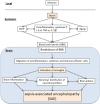Immunosenescence in neurocritical care
- PMID: 30349725
- PMCID: PMC6186132
- DOI: 10.1186/s40560-018-0333-5
Immunosenescence in neurocritical care
Abstract
Background: Several advanced and developing countries are now entering a superaged society, in which the percentage of elderly people exceeds 20% of the total population. In such an aging society, the number of age-related diseases such as malignant tumors, diabetes, and severe infections including sepsis is increasing, and patients with such disorders often find themselves in the ICU.
Main body: Age-related diseases are closely related to age-induced immune dysfunction, by which reductions in the efficiency and specificity of the immune system are collectively termed "immunosenescence." The most noticeable is a decline in the antigen-specific acquired immune response. The exhaustion of T cells in elderly sepsis is related to an increase in nosocomial infections after septicemia, and even death over subacute periods. Another characteristic is that senescent cells that accumulate in body tissues over time cause chronic inflammation through the secretion of proinflammatory cytokines, termed senescence-associated secretory phenotype. Chronic inflammation associated with aging has been called "inflammaging," and similar age-related diseases are becoming an urgent social problem.
Conclusion: In neuro ICUs, several neuro-related diseases including stroke and sepsis-associated encephalopathy are related to immunosenescence and neuroinflammation in the elderly. Several advanced countries with superaged societies face the new challenge of improving the long-term prognosis of neurocritical patients.
Keywords: Elderly; Immune paralysis; Immunosenescence; Sepsis.
Conflict of interest statement
Not applicable.Not applicable.The authors declare that they have no competing interests.Springer Nature remains neutral with regard to jurisdictional claims in published maps and institutional affiliations.
Figures





References
Publication types
LinkOut - more resources
Full Text Sources

